谢孟媛英文初级文法全集笔记完美版
- 格式:docx
- 大小:124.18 KB
- 文档页数:82
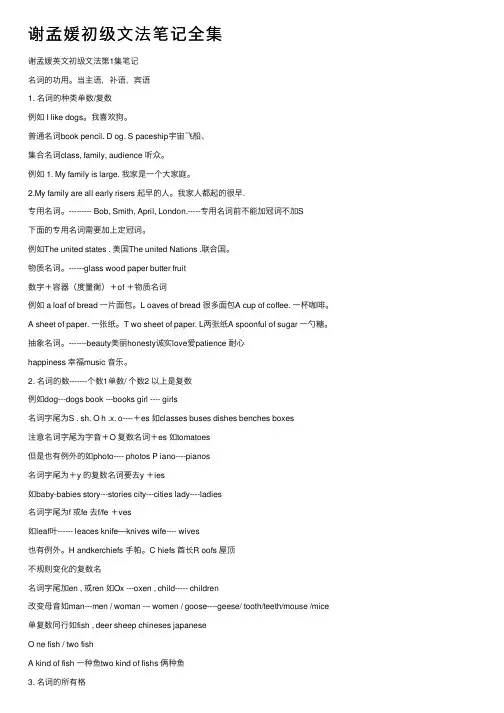
谢孟媛初级⽂法笔记全集谢孟媛英⽂初级⽂法第1集笔记名词的功⽤。
当主语,补语,宾语1. 名词的种类单数/复数例如 I like dogs。
我喜欢狗。
普通名词book pencil. D og. S paceship宇宙飞船、集合名词class, family, audience 听众。
例如 1. My family is large. 我家是⼀个⼤家庭。
2.My family are all early risers 起早的⼈。
我家⼈都起的很早.专⽤名词。
--------- Bob, Smith, April, London.-----专⽤名词前不能加冠词不加S下⾯的专⽤名词需要加上定冠词。
例如The united states . 美国The united Nations .联合国。
物质名词。
------glass wood paper butter fruit数字+容器(度量衡)+of +物质名词例如 a loaf of bread ⼀⽚⾯包。
L oaves of bread 很多⾯包A cup of coffee. ⼀杯咖啡。
A sheet of paper. ⼀张纸。
T wo sheet of paper. L两张纸A spoonful of sugar ⼀勺糖。
抽象名词。
-------beauty美丽honesty诚实love爱patience 耐⼼happiness 幸福music ⾳乐。
2. 名词的数-------个数1单数/ 个数2 以上是复数例如dog---dogs book ---books girl ---- girls名词字尾为S . sh. O h .x. o----+es 如classes buses dishes benches boxes注意名词字尾为字⾳+O 复数名词+es 如tomatoes但是也有例外的如photo---- photos P iano----pianos名词字尾为+y 的复数名词要去y +ies如baby-babies story---stories city---cities lady----ladies名词字尾为f 或fe 去f/fe +ves如leaf叶------ leaces knife—knives wife---- wives也有例外。
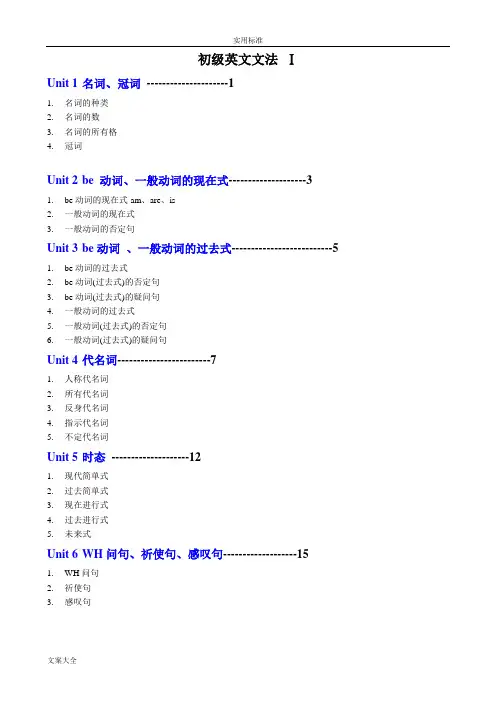
实用标准初级英文文法ⅠUnit 1 名词、冠词---------------------11.名词的种类2.名词的数3.名词的所有格4.冠词Unit 2 be 动词、一般动词的现在式--------------------31.be动词的现在式-am、are、is2.一般动词的现在式3.一般动词的否定句Unit 3 be动词、一般动词的过去式--------------------------51.be动词的过去式2.be动词(过去式)的否定句3.be动词(过去式)的疑问句4.一般动词的过去式5.一般动词(过去式)的否定句6.一般动词(过去式)的疑问句Unit 4 代名词------------------------71.人称代名词2.所有代名词3.反身代名词4.指示代名词5.不定代名词Unit 5 时态--------------------121.现代简单式2.过去简单式3.现在进行式4.过去进行式5.未来式Unit 6 WH问句、祈使句、感叹句-------------------151.WH问句2.祈使句3.感叹句Unit 1 名词、冠词名词,用来表示人或事物、动物,能做为主语、补语、受词。
其中可计数的,称为可数名词;不可计数的,称为不可数名词。
1. 名词的种类表示具有一定形状的个体,为可数名词,有单数/复数之分。
例:book(书)、pencil(铅笔)、dog(狗)、spaceship(太空船)等。
表示一个单位的群体,或者表示被视做整体的人、事、物的集合体。
例:class(班级;班上的同学)、family(家庭;家人)、audience(听众)等。
例 1. My family is large. 我家是一个大家庭。
2. My family are all early risers. 我的家人都起得早。
如人名、地名等,用来表示其一特定的名称。
无冠词,第一个字母须大写。
例:Bob(鲍伯)、Smith(史密斯)、April(四月)、London(伦敦)……等。
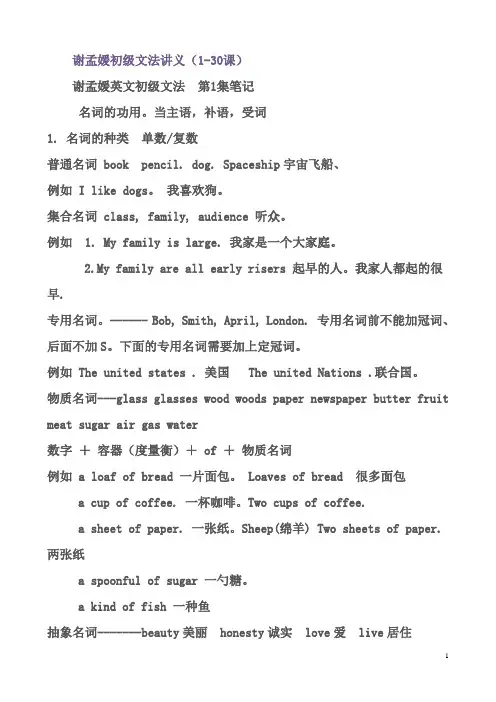
谢孟媛初级文法讲义(1-30课)谢孟媛英文初级文法第1集笔记名词的功用。
当主语,补语,受词1. 名词的种类单数/复数普通名词 book pencil. dog. Spaceship宇宙飞船、例如 I like dogs。
我喜欢狗。
集合名词 class, family, audience 听众。
例如 1. My family is large. 我家是一个大家庭。
2.My family are all early risers 起早的人。
我家人都起的很早.专用名词。
------ Bob, Smith, April, London. 专用名词前不能加冠词、后面不加S。
下面的专用名词需要加上定冠词。
例如 The united states . 美国 The united Nations .联合国。
物质名词---glass glasses wood woods paper newspaper butter fruit meat sugar air gas water数字+容器(度量衡)+ of +物质名词例如 a loaf of bread 一片面包。
Loaves of bread 很多面包a cup of coffee. 一杯咖啡。
Two cups of coffee.a sheet of paper. 一张纸。
Sheep(绵羊) Two sheets of paper. 两张纸a spoonful of sugar 一勺糖。
a kind of fish 一种鱼抽象名词-------beauty美丽 honesty诚实 love爱 live居住life(生活) patience 耐心happy幸福的 happiness 幸福 music 音乐。
2. 名词的数-------个数1单数/ 个数2 以上是复数(七种变化)1、例如 dog---dogs book ---books girl ---- girls2、名词字尾为 s. sh. ch .x. o----+ es 如 classes buses dishes benches boxes注意名词字尾为字音+ O 复数名词+es 如tomato---tomatoes也有例外的如 photo---- photos phone(电话) Piano----pianos3、名词字尾为+y 的复数名词要去y + ies如 baby-babies boy(男孩) cowboy(牛仔) story(小说)---stories city---cities lady----ladies4、名词字尾为f 或fe 去 f/fe + ves如 leaf叶------ leaves knife—knives wife---- wives也有例外。
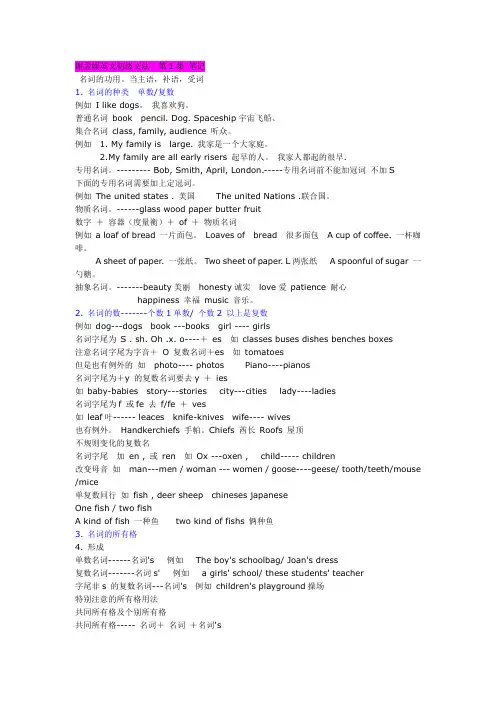
谢孟媛英文初级文法第1集笔记名词的功用。
当主语,补语,受词1. 名词的种类单数/复数例如I like dogs。
我喜欢狗。
普通名词book pencil. Dog. Spaceship宇宙飞船、集合名词class, family, audience 听众。
例如 1. My family is large. 我家是一个大家庭。
2.My family are all early risers 起早的人。
我家人都起的很早.专用名词。
--------- Bob, Smith, April, London.-----专用名词前不能加冠词不加S下面的专用名词需要加上定冠词。
例如The united states . 美国The united Nations .联合国。
物质名词。
------glass wood paper butter fruit数字+容器(度量衡)+of +物质名词例如a loaf of bread 一片面包。
Loaves of bread 很多面包 A cup of coffee. 一杯咖啡。
A sheet of paper. 一张纸。
Two sheet of paper. L两张纸 A spoonful of sugar 一勺糖。
抽象名词。
-------beauty美丽honesty诚实love爱patience 耐心happiness 幸福music 音乐。
2. 名词的数-------个数1单数/ 个数2 以上是复数例如dog---dogs book ---books girl ---- girls名词字尾为S . sh. Oh .x. o----+es 如classes buses dishes benches boxes注意名词字尾为字音+O 复数名词+es 如tomatoes但是也有例外的如photo---- photos Piano----pianos名词字尾为+y 的复数名词要去y +ies如baby-babies story---stories city---cities lady----ladies名词字尾为f 或fe 去f/fe +ves如leaf叶------ leaces knife-knives wife---- wives也有例外。
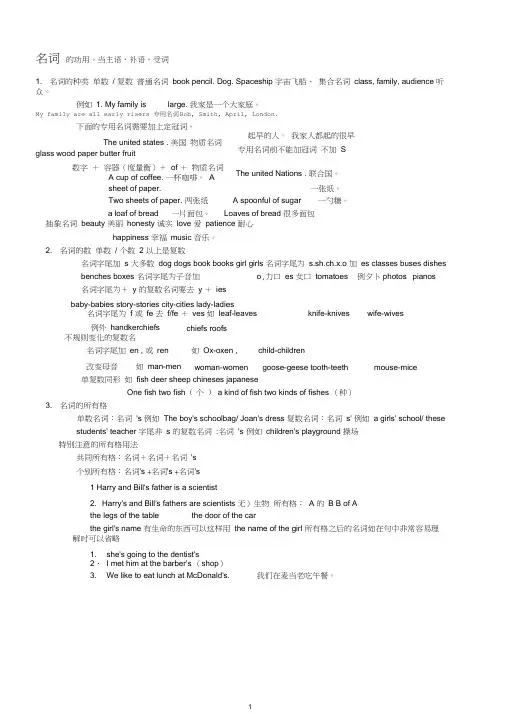
名词 的功用。
当主语,补语,受词1. 名词的种类 单数 / 复数 普通名词 book pencil. Dog. Spaceship 宇宙飞船、 集合名词 class, family, audience 听众。
例如 1. My family islarge. 我家是一个大家庭。
My family are all early risers 专用名词 Bob, Smith, April, London.下面的专用名词需要加上定冠词。
The united states . 美国 物质名词 glass wood paper butter fruit数字 + 容器(度量衡)+ of + 物质名词A cup of coffee. 一杯咖啡。
A sheet of paper.一张纸。
Two sheets of paper. 两张纸A spoonful of sugar一勺糖。
抽象名词 beauty 美丽 honesty 诚实 love 爱 patience 耐心happiness 幸福 music 音乐。
2. 名词的数 单数 / 个数 2 以上是复数名词字尾加 s 大多数 dog dogs book books girl girls 名词字尾为 s.sh.ch.x.o 加 es classes buses dishes benches boxes 名词字尾为子音加 o ,力口 es 女口 tomatoes 例夕卜photos pianos名词字尾为+ y 的复数名词要去 y + ies baby-babies story-stories city-cities lady-ladies名词字尾为 f 或 fe 去 f/fe + ves 如 leaf-leaves knife-knives wife-wives例外 handkerchiefschiefs roofs不规则变化的复数名名词字尾加 en , 或 ren 如 Ox-oxen , child-children改变母音如 man-menwoman-womengoose-geese tooth-teethmouse-mice单复数同形 如 fish deer sheep chineses japaneseOne fish two fish ( 个 ) a kind of fish two kinds of fishes (种)3. 名词的所有格单数名词:名词 's 例如 The boy's schoolbag/ Joan's dress 复数名词:名词 s' 例如 a girls' school/ these students' teacher 字尾非 s 的复数名词 :名词 's 例如 children's playground 操场 特别注意的所有格用法共同所有格:名词+名词+名词 's 个别所有格:名词's +名词's +名词's1 Harry and Bill's father is a scientist2. Harry's and Bill's fathers are scientists 无)生物 所有格: A 的 B B of A the legs of the tablethe door of the carthe girl's name 有生命的东西可以这样用 the name of the girl 所有格之后的名词如在句中非常容易理解时可以省略1. she's going to the dentist's2. I met him at the barber's (shop ) 3. We like to eat lunch at McDonald's.我们在麦当老吃午餐。
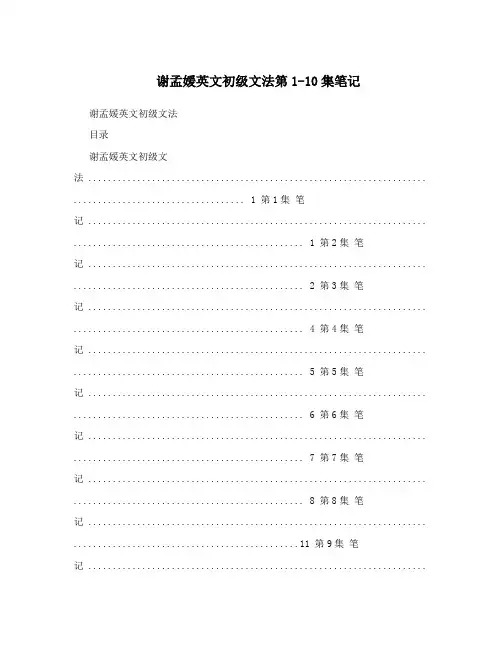
谢孟媛英文初级文法第1-10集笔记谢孟媛英文初级文法目录谢孟媛英文初级文法 ..................................................................... ................................... 1 第1集笔记 ..................................................................... ............................................... 1 第2集笔记 ..................................................................... ............................................... 2 第3集笔记 ..................................................................... ............................................... 4 第4集笔记 ..................................................................... ............................................... 5 第5集笔记 ..................................................................... ............................................... 6 第6集笔记 ..................................................................... ............................................... 7 第7集笔记 ..................................................................... ............................................... 8 第8集笔记 ..................................................................... ..............................................11 第9集笔记 .................................................................................................................. 12 第10集笔记...................................................................... . (14)第1集笔记Unit名词的功用。
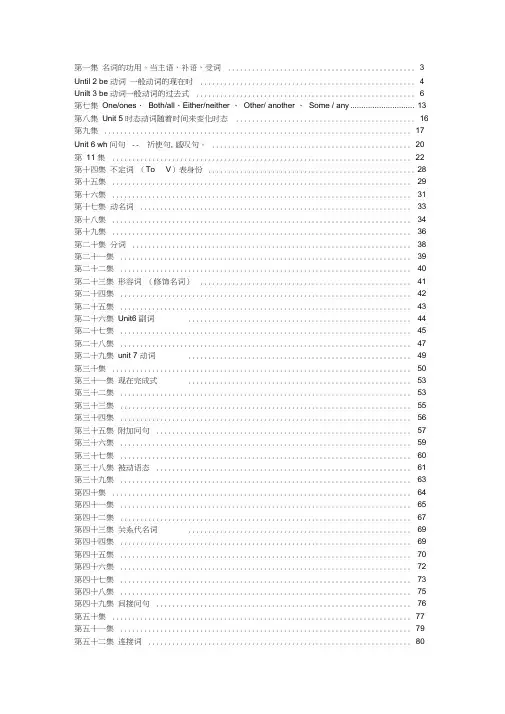
第一集名词的功用。
当主语,补语,受词 (3)Until 2 be 动词一般动词的现在时 (4)Unilt 3 be 动词一般动词的过去式 (6)第七集One/ones、Both/all、Either/neither 、Other/ another 、Some / any (13)第八集Unit 5 时态动词随着时间来变化时态 (16)第九集 (17)Unit 6 wh 问句-- 祈使句, 感叹句。
(20)第11 集 (22)第十四集不定词(To V)表身份 (28)第十五集 (29)第十六集 (31)第十七集动名词 (33)第十八集 (34)第十九集 (36)第二十集分词 (38)第二十一集 (39)第二十二集 (40)第二十三集形容词(修饰名词) (41)第二十四集 (42)第二十五集 (43)第二十六集Unit6 副词 (44)第二十七集 (45)第二十八集 (47)第二十九集unit 7 动词 (49)第三十集 (50)第三十一集现在完成式 (53)第三十二集 (53)第三十三集 (55)第三十四集 (56)第三十五集附加问句 (57)第三十六集 (59)第三十七集 (60)第三十八集被动语态 (61)第三十九集 (63)第四十集 (64)第四十一集 (65)第四十二集 (67)第四十三集关系代名词 (69)第四十四集 (69)第四十五集 (70)第四十六集 (72)第四十七集 (73)第四十八集 (75)第四十九集间接问句 (76)第五十集 (77)第五十一集 (79)第五十二集连接词 (80)第五十三集 (81)第五十四集 (82)第五十五集 (83)第五十六集 (84)第五十七集 (85)第五十八集介系词 (86)第五十九集 (88)第六十集 (90)谢孟媛英文初级文法第一集Unitl名词的功用当主语,补语,受词一、名词的种类单数/ 复数例如I like dogs 。
我喜欢狗。
1、普通名词book pencil. Dog. Spaceship 宇宙飞船、2、集合名词class, family, audience 听众。
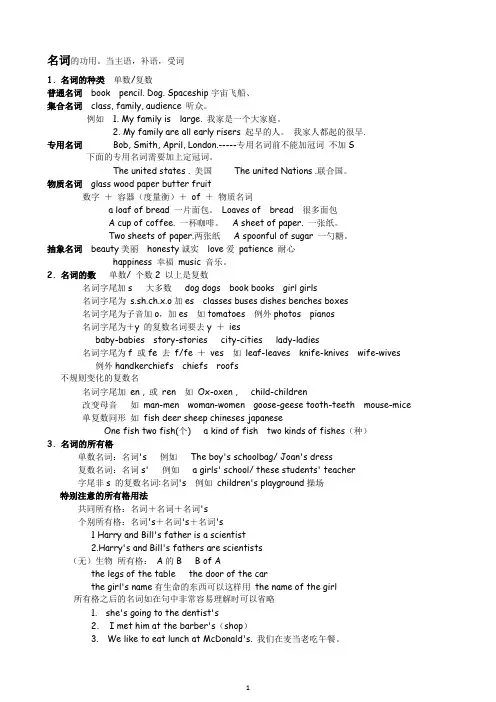
名词的功用。
当主语,补语,受词1. 名词的种类单数/复数普通名词book pencil. Dog. Spaceship宇宙飞船、集合名词class, family, audience 听众。
例如 1. My family is large. 我家是一个大家庭。
2. My family are all early risers 起早的人。
我家人都起的很早.专用名词Bob, Smith, April, London.-----专用名词前不能加冠词不加S下面的专用名词需要加上定冠词。
The united states . 美国The united Nations .联合国。
物质名词glass wood paper butter fruit数字+容器(度量衡)+of +物质名词a loaf of bread 一片面包。
Loaves of bread 很多面包A cup of coffee. 一杯咖啡。
A sheet of paper. 一张纸。
Two sheets of paper.两张纸 A spoonful of sugar 一勺糖。
抽象名词beauty美丽honesty诚实love爱patience 耐心happiness 幸福music 音乐。
2. 名词的数单数/ 个数2 以上是复数名词字尾加s 大多数dog dogs book books girl girls名词字尾为s.sh.ch.x.o加es classes buses dishes benches boxes名词字尾为子音加o,加es 如tomatoes 例外photos pianos名词字尾为+y 的复数名词要去y +iesbaby-babies story-stories city-cities lady-ladies名词字尾为f 或fe 去f/fe +ves 如leaf-leaves knife-knives wife-wives 例外handkerchiefs chiefs roofs不规则变化的复数名名词字尾加en , 或ren 如Ox-oxen , child-children改变母音如man-men woman-women goose-geese tooth-teeth mouse-mice 单复数同形如fish deer sheep chineses japaneseOne fish two fish(个) a kind of fish two kinds of fishes(种)3. 名词的所有格单数名词:名词's 例如The boy's schoolbag/ Joan's dress复数名词:名词s' 例如 a girls' school/ these students' teacher字尾非s 的复数名词:名词's 例如children's playground操场特别注意的所有格用法共同所有格:名词+名词+名词's个别所有格:名词's+名词's+名词's1 Harry and Bill's father is a scientist2.Harry's and Bill's fathers are scientists(无)生物所有格:A的B B of Athe legs of the table the door of the carthe girl's name有生命的东西可以这样用the name of the girl所有格之后的名词如在句中非常容易理解时可以省略1. she's going to the dentist's2.I met him at the barber's(shop)3. We like to eat lunch at McDonald's. 我们在麦当老吃午餐。
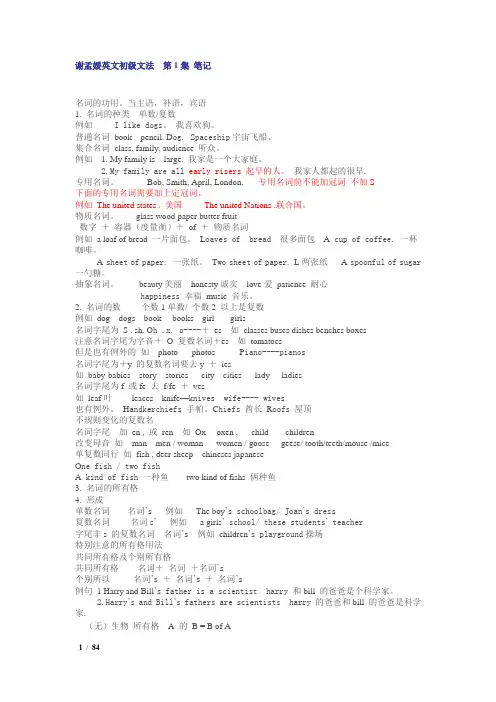
谢孟媛英文初级文法第1集笔记名词的功用。
当主语,补语,宾语1. 名词的种类单数/复数例如 I like dogs。
我喜欢狗。
普通名词book pencil. D og. S paceship宇宙飞船、集合名词class, family, audience 听众。
例如 1. My family is large. 我家是一个大家庭。
2.My family are all early risers 起早的人。
我家人都起的很早.专用名词。
--------- Bob, Smith, April, London.-----专用名词前不能加冠词不加S下面的专用名词需要加上定冠词。
例如The united states . 美国The united Nations .联合国。
物质名词。
------glass wood paper butter fruit数字+容器(度量衡)+of +物质名词例如a loaf of bread 一片面包。
L oaves of bread 很多面包A cup of coffee. 一杯咖啡。
A sheet of paper. 一张纸。
T wo sheet of paper. L两张纸A spoonful of sugar 一勺糖。
抽象名词。
-------beauty美丽honesty诚实love爱patience 耐心happiness 幸福music 音乐。
2. 名词的数-------个数1单数/ 个数2 以上是复数例如dog---dogs book ---books girl ---- girls名词字尾为S . sh. O h .x. o----+es 如classes buses dishes benches boxes注意名词字尾为字音+O 复数名词+es 如tomatoes但是也有例外的如photo---- photos P iano----pianos名词字尾为+y 的复数名词要去y +ies如baby-babies story---stories city---cities lady----ladies名词字尾为f 或fe 去f/fe +ves如leaf叶------ leaces knife—knives wife---- wives也有例外。
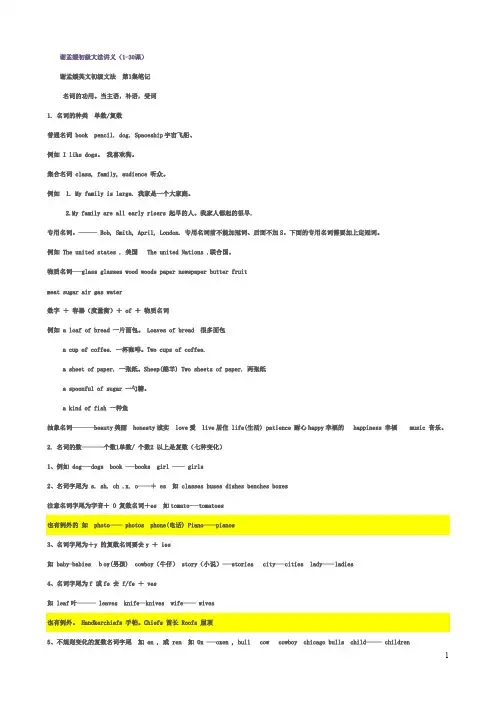
谢孟媛初级文法讲义(1-30课)谢孟媛英文初级文法第1集笔记名词的功用。
当主语,补语,受词1. 名词的种类单数/复数普通名词 book pencil. dog. Spaceship宇宙飞船、例如 I like dogs。
我喜欢狗。
集合名词 class, family, audience 听众。
例如 1. My family is large. 我家是一个大家庭。
2.My family are all early risers 起早的人。
我家人都起的很早.专用名词。
------ Bob, Smith, April, London. 专用名词前不能加冠词、后面不加S。
下面的专用名词需要加上定冠词。
例如 The united states . 美国 The united Nations .联合国。
物质名词---glass glasses wood woods paper newspaper butter fruitmeat sugar air gas water数字+容器(度量衡)+ of +物质名词例如 a loaf of bread 一片面包。
Loaves of bread 很多面包a cup of coffee. 一杯咖啡。
Two cups of coffee.a sheet of paper. 一张纸。
Sheep(绵羊) Two sheets of paper. 两张纸a spoonful of sugar 一勺糖。
a kind of fish 一种鱼抽象名词-------beauty美丽 honesty诚实 love爱 live居住 life(生活) patience 耐心happy幸福的 happiness 幸福 music 音乐。
2. 名词的数-------个数1单数/ 个数2 以上是复数(七种变化)1、例如 dog---dogs book ---books girl ---- girls2、名词字尾为 s. sh. ch .x. o----+ es 如 classes buses dishes benches boxes注意名词字尾为字音+ O 复数名词+es 如tomato---tomatoes也有例外的如 photo---- photos phone(电话) Piano----pianos3、名词字尾为+y 的复数名词要去y + ies如 baby-babies boy(男孩) cowboy(牛仔) story(小说)---stories city---cities lady----ladies4、名词字尾为f 或fe 去 f/fe + ves如 leaf叶------ leaves knife—knives wife---- wives也有例外。
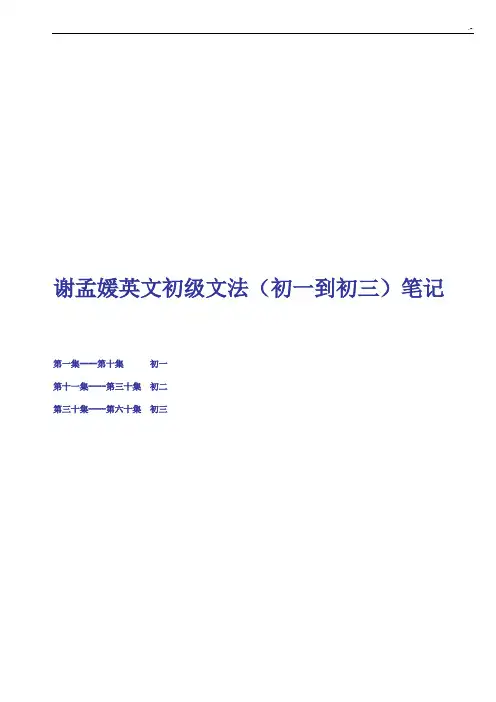
.-谢孟媛英文初级文法(初一到初三)笔记第一集----第十集初一第十一集----第三十集初二第三十集----第六十集初三第1集U nit 1 名词名词的功用:当主语,补语,宾语1. 名词的种类 --- 单数/复数例如:I like dogs。
我喜欢狗。
普通名词:book pencil. D og. S paceship宇宙飞船、集合名词:class, family, audience 听众。
例如:1. My family is large. 我家是一个大家庭。
2.My family are all early risers 起早的人。
我家人都起的很早.专用名词:--------- Bob, Smith, April, London.-----专用名词前不能加冠词不加S下面的专用名词需要加上定冠词。
例如The united states . 美国The united Nations .联合国。
物质名词。
------glass wood paper butter fruit数字+容器(度量衡)+of +物质名词例如 a loaf of bread 一片面包。
L oaves of bread 很多面包A cup of coffee. 一杯咖啡。
A sheet of paper. 一张纸。
T wo sheet of paper. L两张纸A spoonful of sugar 一勺糖。
抽象名词。
-------beauty美丽honesty诚实love爱patience 耐心happiness 幸福music 音乐。
2. 名词的数----个数1单数/ 个数2 以上是复数例如:dog---dogs book ---books girl ---- girls名词字尾为S . sh. O h .x. o----+es 如classes buses dishes benches boxes注意名词字尾为字音+O 复数名词+es 如tomatoes但是也有例外的如photo---- photos P iano----pianos名词字尾为+y 的复数名词要去y +ies如baby-babies story---stories city---cities lady----ladies名词字尾为f 或fe 去f/fe +ves如:leaf叶------ leaces knife—knives wife---- wives也有例外:H andkerchiefs 手帕C hiefs 酋长R oofs 屋顶不规则变化的复数名名词字尾加en , 或ren 如Ox ---oxen , child----- children改变母音如man---men / woman --- women / goose----geese/ tooth/teeth/mouse /mice单复数同行如fish , deer sheep chineses japaneseO ne fish / two fishA kind of fish 一种鱼two kind of fishs 俩种鱼3. 名词的所有格⑴:形成单数名词------名词’s 例如The boy’s schoolbag/ Joan’s dress复数名词-------名词s’例如 a girls’ school/ these students’ teacher字尾非s 的复数名词---名词’s 例如children’s playground操场特别注意的所有格用法共同所有格及个别所有格共同所有格----- 名词+名词+名词’s个别所以--------名词’s +名词’s +名词’s例句:1 Harry and Bill’s father is a scientist harry 和bill 的爸爸是个科学家。
谢孟媛英文初级文法第1集笔记名词的功用。
当主语,补语,受词1. 名词的种类单数/复数例如 I like dogs。
我喜欢狗。
普通名词book pencil. D og. S paceship宇宙飞船、集合名词class, family, audience 听众。
例如 1. My family is large. 我家是一个大家庭。
2.My family are all early risers 起早的人。
我家人都起的很早.专用名词。
--------- Bob, Smith, April, London.-----专用名词前不能加冠词不加S下面的专用名词需要加上定冠词。
例如The united states . 美国The united Nations .联合国。
物质名词。
------glass wood paper butter fruit数字+容器(度量衡)+of +物质名词例如a loaf of bread 一片面包。
L oaves of bread 很多面包A cup of coffee. 一杯咖啡。
A sheet of paper. 一张纸。
T wo sheet of paper. L两张纸A spoonful of sugar 一勺糖。
抽象名词。
-------beauty美丽honesty诚实love爱patience 耐心happiness 幸福music 音乐。
2. 名词的数-------个数1单数/ 个数2 以上是复数例如dog---dogs book ---books girl ---- girls名词字尾为S . sh. O h .x. o----+es 如classes buses dishes benches boxes注意名词字尾为字音+O 复数名词+es 如tomatoes但是也有例外的如photo---- photos P iano----pianos名词字尾为+y 的复数名词要去y +ies如baby-babies story---stories city---cities lady----ladies名词字尾为f 或fe 去f/fe +ves如leaf叶------ leaces knife—knives wife---- wives也有例外。
谢孟媛初级文法讲义(笔记)-(修复的)谢孟媛英文初级文法第1集笔记Unit1 名词名词的功用:当主语,补语,宾语1. 名词的种类(单数/复数)例:I like dogs. 我喜欢狗。
普通名词:book / pencil/ dog/ spaceship宇宙飞船集合名词:class / family/ audience 听众例1. My family is large. 我家是一个大家庭。
2. My family are all early risers.我家人都起的很早. 专用名词:Bob/ Smith/ April/ London. 专用名词前不能加冠词,不加s下面的专用名词需要加上定冠词例: The United States 美国The United Nations .联合国物质名词:glass/ wood/ paper/ butter/ fruit数字+容器(度量衡)+of +物质名词例: a loaf of bread 一片面包loaves of bread 很多面包 a cup of coffee 一杯咖啡a sheet of paper. 一张纸two sheets of paper两张纸 a spoonful of sugar 一勺糖抽象名词:beauty美丽/ honesty诚实/ love爱/ patience 耐心/ happiness 幸福/ music 音乐2. 名词的数---- 单数:个数为1 复数:个数为2及以上规则变化的复数名词名词字尾+s ,大部分名词例:dog---dogs book ---books girl ---- girls名词字尾为s/sh/ch/x/o 复数名词+es 如: classes, buses, dishes, benches, boxes, dishes注意名词字尾为子音+o, 复数名词+es 如tomatoes 但是也有例外的如photo---- photosPiano----pianos名词字尾为子音+y, 复数名词要去y +ies如baby-babies story---stories city---citieslady----ladies名词字尾为f 或fe 去f/fe +ves如:leaf叶---- leaves knife ---- knives wife ---- wives也有例外: handkerchiefs 手帕chiefs 首领,领袖roofs 屋顶不规则变化的复数名词名词字尾加en / ren 如Ox ---oxen , child----- children改变母音,如:man---men / woman --- women / goose----geese 鹅/ tooth---teeth / mouse---mice单复数同形,如:fish , deer, sheep chineses japaneseone fish / two fisha kind of fish 一种鱼two kinds of fishes 两种鱼3. 名词的所有格形成:单数名词== 名词’s 例: t he boy’s schoolbag / Joan’s dress复数名词== 名词s’ 例: a girls’ school / these students’ tea cher字尾非s 的复数名词== 名词’s 例如children’s playground操场特别注意的所有格用法: 共同所有格及个别所有格共同所有格---- 名词+名词+名词’s个别所有格---- 名词’s +名词’s +名词’s例1. Harry and Bill’s father is a scientist. Harry 和Bill 的爸爸是个科学家。
谢孟媛初级文法讲义(1-30课)谢孟媛英文初级文法第1集笔记名词的功用。
当主语,补语,受词1. 名词的种类单数/复数普通名词 book pencil. dog. Spaceship宇宙飞船、例如 I like dogs。
我喜欢狗。
集合名词 class, family, audience 听众。
例如 1. My family is large. 我家是一个大家庭。
2.My family are all early risers 起早的人。
我家人都起的很早.专用名词。
------ Bob, Smith, April, London. 专用名词前不能加冠词、后面不加S。
下面的专用名词需要加上定冠词。
例如 The united states . 美国 The united Nations .联合国。
物质名词---glass glasses wood woods paper newspaper butter fruit meat sugar air gas water数字+容器(度量衡)+ of +物质名词例如 a loaf of bread 一片面包。
Loaves of bread 很多面包a cup of coffee. 一杯咖啡。
Two cups of coffee.a sheet of paper. 一张纸。
Sheep(绵羊) Two sheets of paper. 两张纸a spoonful of sugar 一勺糖。
a kind of fish 一种鱼抽象名词-------beauty美丽 honesty诚实 love爱 live居住life(生活) patience 耐心happy幸福的 happiness 幸福 music 音乐。
2. 名词的数-------个数1单数/ 个数2 以上是复数(七种变化)1、例如 dog---dogs book ---books girl ---- girls2、名词字尾为 s. sh. ch .x. o----+ es 如 classes buses dishes benches boxes注意名词字尾为字音+ O 复数名词+es 如tomato---tomatoes也有例外的如 photo---- photos phone(电话) Piano----pianos3、名词字尾为+y 的复数名词要去y + ies如 baby-babies boy(男孩) cowboy(牛仔) story(小说)---stories city---cities lady----ladies4、名词字尾为f 或fe 去 f/fe + ves如 leaf叶------ leaves knife—knives wife---- wives也有例外。
谢孟媛英文初级文法第1集笔记Unit1 名词名词的功用:当主语,补语,宾语1. 名词的种类(单数/复数)例:I like dogs. 我喜欢狗。
普通名词:book / pencil/ dog/ spaceship宇宙飞船集合名词:class / family/ audience 听众例1. My family is large. 我家是一个大家庭。
2. My family are all early risers.我家人都起的很早.专用名词:Bob/ Smith/ April/ London. 专用名词前不能加冠词,不加s下面的专用名词需要加上定冠词例: The United States 美国The United Nations .联合国物质名词:glass/ wood/ paper/ butter/ fruit数字+容器(度量衡)+of +物质名词例: a loaf of bread 一片面包loaves of bread 很多面包 a cup of coffee 一杯咖啡a sheet of paper. 一张纸two sheets of paper两张纸 a spoonful of sugar 一勺糖抽象名词:beauty美丽/ honesty诚实/ love爱/ patience 耐心/ happiness 幸福/ music 音乐2. 名词的数---- 单数:个数为1 复数:个数为2及以上规则变化的复数名词名词字尾+s ,大部分名词例:dog---dogs book ---books girl ---- girls名词字尾为s/sh/ch/x/o复数名词+es 如: classes, buses, dishes, benches, boxes, dishes 注意名词字尾为子音+o, 复数名词+es 如tomatoes但是也有例外的如photo---- photos Piano----pianos名词字尾为子音+y, 复数名词要去y +ies如baby-babies story---stories city---cities lady----ladies名词字尾为f 或fe 去f/fe +ves如:leaf叶---- leaves knife ---- knives wife ---- wives也有例外: handkerchiefs 手帕chiefs 首领,领袖roofs 屋顶不规则变化的复数名词名词字尾加en / ren 如Ox ---oxen , child----- children改变母音,如:man---men / woman --- women / goose----geese 鹅/ tooth---teeth / mouse---mice单复数同形,如:fish , deer, sheep chineses japaneseone fish / two fisha kind of fish 一种鱼two kinds of fishes 两种鱼3. 名词的所有格形成:单数名词== 名词’s 例: t he boy’s schoolbag/ Joan’s dress复数名词== 名词s’ 例: a girls’ school/ these students’ teacher字尾非s 的复数名词== 名词’s 例如children’s playground操场特别注意的所有格用法: 共同所有格及个别所有格共同所有格---- 名词+名词+名词’s个别所有格---- 名词’s +名词’s +名词’s例1. Harry and Bill’s father is a scientist. Harry 和Bill 的爸爸是个科学家。
谢孟媛初级文法讲义(笔记) (修复的)(总57页)-CAL-FENGHAI.-(YICAI)-Company One1-CAL-本页仅作为文档封面,使用请直接删除谢孟媛英文初级文法第 1集笔记Unit1 名词名词的功用:当主语,补语,宾语1. 名词的种类 (单数/复数)例: I like dogs. 我喜欢狗。
普通名词:book / pencil/ dog/ spaceship宇宙飞船集合名词:class / family/ audience 听众例1. My family is large. 我家是一个大家庭。
2. My family are all early risers.我家人都起的很早.专用名词:Bob/ Smith/ April/ London. 专用名词前不能加冠词,不加s下面的专用名词需要加上定冠词例: The United States 美国 The United Nations .联合国物质名词: glass/ wood/ paper/ butter/ fruit数字+容器(度量衡)+ of +物质名词例: a loaf of bread 一片面包 loaves of bread 很多面包 a cup of coffee 一杯咖啡a sheet of paper. 一张纸 two sheets of paper两张纸 a spoonful of sugar 一勺糖抽象名词:beauty美丽 / honesty诚实/ love爱/ patience 耐心/ happiness 幸福/ music 音乐2. 名词的数 ---- 单数:个数为1 复数:个数为2及以上规则变化的复数名词名词字尾+s ,大部分名词例: dog---dogs book ---books girl ---- girls名词字尾为s/sh/ch/x/o复数名词+ es 如: classes, buses, dishes, benches, boxes, dishes注意名词字尾为子音+o, 复数名词+es 如 tomatoes但是也有例外的如 photo---- photos Piano----pianos名词字尾为子音+y, 复数名词要去y + ies如 baby-babies story---stories city---cities lady----ladies名词字尾为f 或fe 去 f/fe + ves如: leaf叶 ---- leaves knife ---- knives wife ---- wives也有例外: handkerchiefs 手帕 chiefs 首领,领袖 roofs 屋顶不规则变化的复数名词名词字尾加 en / ren 如 Ox ---oxen , child----- children改变母音,如: man---men / woman --- women / goose----geese 鹅 / tooth---teeth / mouse---mice 单复数同形,如: fish , deer, sheep chineses japaneseone fish / two fisha kind of fish 一种鱼 two kinds of fishes 两种鱼3. 名词的所有格形成:单数名词 == 名词’s 例: t he boy’s schoolbag/ Joan’s dress复数名词 == 名词s’ 例: a girls’ school / these s tudents’ teacher字尾非s 的复数名词 == 名词’s 例如children’s playground操场特别注意的所有格用法 : 共同所有格及个别所有格共同所有格 ---- 名词+名词+名词’s个别所有格 ---- 名词’s +名词’s +名词’s例1. Harry and Bill’s father is a scientist. Harry 和Bill 的爸爸是个科学家。
谢孟媛初级文法讲义笔记修复的Document number【SA80SAB-SAA9SYT-SAATC-SA6UT-SA18】谢孟媛英文初级文法第 1集笔记Unit1 名词名词的功用:当主语,补语,宾语1. 名词的种类 (单数/复数)例: I like dogs. 我喜欢狗。
普通名词:book / pencil/ dog/ spaceship宇宙飞船集合名词:class / family/ audience 听众例1. My family is large. 我家是一个大家庭。
2. My family are all early risers.我家人都起的很早.专用名词:Bob/ Smith/ April/ London. 专用名词前不能加冠词,不加s下面的专用名词需要加上定冠词例: The United States 美国 The United Nations .联合国物质名词: glass/ wood/ paper/ butter/ fruit数字+容器(度量衡)+ of +物质名词例: a loaf of bread 一片面包 loaves of bread 很多面包 a cup of coffee 一杯咖啡a sheet of paper. 一张纸 two sheets of paper两张纸 a spoonful of sugar 一勺糖抽象名词:beauty美丽 / honesty诚实/ love爱/ patience 耐心/ happiness 幸福/ music 音乐2. 名词的数 ---- 单数:个数为1 复数:个数为2及以上规则变化的复数名词名词字尾+s ,大部分名词例: dog---dogs book ---books girl ---- girls名词字尾为s/sh/ch/x/o复数名词+ es 如: classes, buses, dishes, benches, boxes, dishes注意名词字尾为子音+o, 复数名词+es 如 tomatoes但是也有例外的如 photo---- photos Piano----pianos名词字尾为子音+y, 复数名词要去y + ies如 baby-babies story---stories city---cities lady----ladies名词字尾为f 或fe 去 f/fe + ves如: leaf叶 ---- leaves knife ---- knives wife ---- wives也有例外: handkerchiefs 手帕 chiefs 首领,领袖 roofs 屋顶不规则变化的复数名词名词字尾加 en / ren 如 Ox ---oxen , child----- children改变母音,如: man---men / woman --- women / goose----geese 鹅 / tooth---teeth / mouse---mice单复数同形,如: fish , deer, sheep chineses japaneseone fish / two fisha kind of fish 一种鱼 two kinds of fishes 两种鱼3. 名词的所有格形成:单数名词 == 名词’s 例: t he boy’s schoolbag/ Joan’s dress复数名词 == 名词s’ 例: a girls’ school/ these students’ teacher字尾非s 的复数名词 == 名词’s 例如children’s playground操场特别注意的所有格用法 : 共同所有格及个别所有格共同所有格 ---- 名词+名词+名词’s个别所有格 ---- 名词’s +名词’s +名词’s例1. Harry and Bill’s father is a scientist. Harry 和Bill 的爸爸是个科学家。
名词的功用。
当主语,补语,受词1. 名词的种类单数/复数普通名词book pencil. Dog. Spaceship宇宙飞船、集合名词class, family, audience 听众。
例如 1. My family is large. 我家是一个大家庭。
2.My family are all early risers 起早的人。
我家人都起的很早.专用名词Bob, Smith, April, London.-----专用名词前不能加冠词不加S下面的专用名词需要加上定冠词。
The united states . 美国The united Nations .联合国。
物质名词glass wood paper butter fruit数字+容器(度量衡)+of +物质名词a loaf of bread 一片面包。
Loaves of bread 很多面包A cup of coffee. 一杯咖啡。
A sheet of paper. 一张纸。
Two sheets of paper.两张纸 A spoonful of sugar 一勺糖。
抽象名词beauty美丽honesty诚实love爱patience 耐心happiness 幸福music 音乐。
2. 名词的数单数/ 个数2 以上是复数名词字尾加s 大多数dogdogs bookbooks girlgirls名词字尾为s.sh.ch.x.o加es classes buses dishes benches boxes名词字尾为子音加o,加es 如tomatoes 例外photos pianos名词字尾为+y 的复数名词要去y +iesbaby-babies story-stories city-cities lady-ladies名词字尾为f 或fe 去f/fe +ves如leaf-leaves knife-knives wife-wives 例外handkerchiefs chiefsroofs不规则变化的复数名名词字尾加en , 或ren 如Ox-oxen , child-children改变母音如man-men woman-women goose-geese tooth-teethmouse-mice单复数同形如fishdeer sheep chineses japaneseOne fishtwo fish(个) a kind of fish two kinds of fishes(种)3. 名词的所有格单数名词:名词's 例如The boy's schoolbag/ Joan's dress复数名词:名词s' 例如 a girls' school/ these students' teacher字尾非s 的复数名词:名词's 例如children's playground操场特别注意的所有格用法共同所有格:名词+名词+名词's个别所有格:名词's+名词's+名词's1 Harry and Bill's father is a scientist2.Harry's and Bill's fathers are scientists(无)生物所有格:A的BB of Athe legs of the table the door of the carthe girl's name有生命的东西可以这样用the name of the girl 所有格之后的名词如在句中非常容易理解时可以省略1. she's going to the dentist's2.I met him at the barber's(shop)3. We like to eat lunch at McDonald's.我们在麦当老吃午餐。
4.冠词分为不定冠词a/an及定冠词the,它通常放在名词前用来修饰名词a/an 的用法子音开头的单数用a a book a girl a young a man母音开头的单数用an母音有5个(AEIOU)anapple an umbrella an old woman a/an 的发音I read a novel.I read a novel,not two.the的用法----母音前读(they)子音前的读(the)the apple the novelPlease shut the door.特指一定要加theThe rich aren't always happy.the+形容词泛指“~~~的人”。
一般动词的现在时1. be 动词的现在时am are is是… 在…We are happy. She is in America.主词(S)+be动词(V)第一人称I am a boy.第二人称、第三人称they/复数名词you、they、复数+areYou are my sons.你们是我的儿子。
第三人称单数+is. He is my student.Be 动词的否定:am/are/is+notHe is not a good baseball player.He isn't a good baseball player.He’s not a good baseball player.are not aren’tBe动词的疑问句肯定句:主词+am/are/is疑问句:am/are/is+主词That is his camera. Is that his camera?The girl is a junior high school student. senior high school 高中Is the girl a junior high school student?junior high school 初中Be动词开头的疑问句可用yes或no回答: Yes,S be. No,S be not.Is that man your math teacher?Yes,he is. No,he isn'tNo,he is my PE teacher.Are you eating your lunch?Yes, I am. No,Iam not.2. 一般动词的现在式习惯性的动作正在做的动作主词+一般动词现在时中主词为第三人称单数:一般动词+s或esIlikedogs. We like dogs.You like dogs. You like dogs.He likes dogs. They like dogs.第三人称单数+s一般动词加s或es的方法:大部分动词加s发音为s或z。
works无声[s],plays有声[z]一般动词字尾为osshch时加esgoes[z] washes[iz] watches[iz]一般动词字尾音为y时去y加ies crycries studystudiesHave和hashave(有/吃)的单数动词为has。
Theyhave a lot of money.(不可数)He hasa lot of money. 三单数用has一般动词的否定句:不可在一般动词后加not必须用助动词do/doesdo用于主词为Iyou 复数does用于主词为第三人称单数否定句:主词+do/does+not+原型动词The twin brothers go to school by bus.The twin brothers do not go to school by bus. don'tSam has dinner at the restaurant.Sam doesn'thavedinner at the restaurant.一般动词的疑问句:Do/Does+主词+动词原型。
You visit your grandmother on Sunday.Do you visit your grandmother on Sunday?He comes from England.Does he come from England?do/does开头的疑问句回答:用yes/no之后用do/ does回答Does the little boy go to school?Yes,he does. No,he doesn't一般过去式be动词一般动词的过去式be 动词的过去式was/were am/is-as are-were过去时be动词的动词表示过去时间中发生的状态,现在不现在式He is busy now.过去式He was busy then.那时他很忙。
时间副词改变,动词时态也必须改变。
My parents are at home now。
我的父母现在在家。
My parents were at home yesterday.我的父母昨天在家。
Be动词(过去式)的否定句:主词+was/were+notMr brown was a vet.否定Mr brown wasn't a vet .Joe and brian were in the living room at that time.at that time=then否定Joe and brian weren't in the living room at that time ,Be动词过去式的疑问句:was/were+主词Wendy was in the seventh grade last year. Wendy去年读7年级。
Was Wendy in the seventh grade last year?Were you a pianist? Piano 钢琴pianist钢琴家。
Yes,I was. No,I wasn't.一般动词的过去式:规则变化/不规则变化规则变化+ed [t][d][id],无声则[t],有声则[d],字尾是[t]或[d]则[id]原型动词+ed helped[p][t] spelled [l][d]wanted [t][id]needed原型动词有e+d loveddancedanced 有例外write worte原型动词为子音+短母音+子音(本身比较短):重复字尾加ed如stopped planned原型动词为子音有y,去y加ied 如study-studied cry-cried不规则变化eat-ateread(瑞得)-read (瑞爱得)注意写法一样读音不同ride-rode come-came have-had see-saw go-went teach-taught give-gave take-tookI walk to school every day.I walked to school yesterday.动词随着时间改变形态Mother goes to a supermarket every morning.Mother went to a supermarket yesterday morning.主词为第三人称单数过去式不需加s。